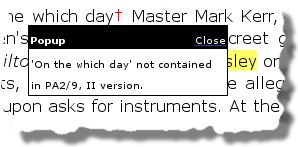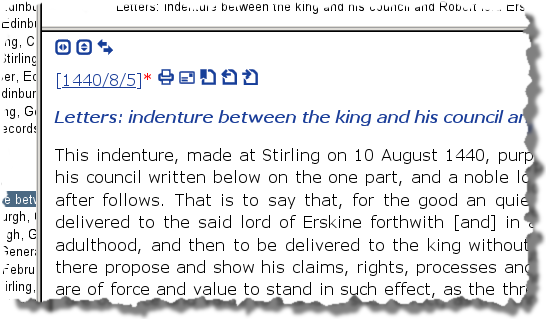Table of Contents
- What information does RPS contain?
- Take a Tour
- How do I search RPS?
- What information am I seeing on the search results screen?
- How can I alter the layout of the record?
- What do the numbers above each record mean?
- What do the icons next to the reference number mean?
- What information is contained in the asterisk and dagger pop-ups?
RPS comprises the manuscript and translated record of the Scottish parliament from the first surviving act of 1235 to the union of 1707. The surviving records of parliament are held in a variety of public and private archives, with the majority in the possession of the National Archives of Scotland and the National Library of Scotland in Edinburgh. The historical records of the Scottish parliament contain a wealth of information on various aspects of Scotland's past, from great matters of state involving political, social, economic and foreign policy, to more everyday concerns reflecting peculiarly local or domestic issues. For more on the diverse range of topics which can be found within the parliamentary records, see the ideas for further research page.
The record is split into four classes of material:
-
Parliamentary Record/Register, General Council or Official Record: this chiefly contains the manuscript collection of statutes, including rolls of parliament, royal letters, judicial proceedings and private business such as ratifications of charters, etc.
-
Parliamentary Minutes: this includes both manuscript minutes taken by the clerk as the official record of day-to-day proceedings and, from the later seventeenth century, contemporary printed minutes, where these supplement the manuscript record.
-
Committee Minutes and Proceedings: this consists of the surviving records of session committees (those committees that were appointed and sat while parliament was meeting), such as the Lords of the Articles. Often fragmentary in nature, this includes the official minutes, when these have survived, and are supplemented by other records, such as reports drafted by committees for submission to parliament. Interval committees (those committees which sat between sessions of parliament) are not included in RPS.
-
Additional Sources: this encompasses a wide range of supplementary material directly related to parliament that is not contained in the classes above, including proceedings of conventions of estates (when these are contained in non-parliamentary sources), printed acts (when these are often the only source to survive), and petitions and other records submitted for consideration in the course of parliamentary business.
To differentiate between the individual class of record, reference numbers are preceded with M (for minutes), C (for committees) or A (for additional) where appropriate. Reference numbers for material from the main parliamentary record have no prefix.
For a visual demonstration of many of the topics covered in this helpfile, please view the flash video here
At the point of searching users can choose to search either the manuscript record or the parallel English translation. The manuscript text contains a transcription of the original parliamentary record as found in the various contemporary sources. Modern punctuation and capitalisation has been imposed and scribal abbreviations expanded, but the original language (predominantly Scots but also Latin, French etc.) and the highly variant spelling of the original is retained. The translated record aims to provide a searchable index to the manuscript record. All material has been translated into English, the spelling of personal names has been standardised and place names modernised, where identifiable. Searching the translated record will therefore provide more accurate results. From the translated record, there are direct links back to the original manuscript version of the text.
Basic searching can be for a single word, a RPS reference
number, a phrase or several search terms joined using Boolean
operators and grouped using brackets. A single word search, e.g.
fair will search documents for any words which
contain the words using the stem fair, e.g.
fairs. Note that
this search is case insensitive.
Searching for phrases
means putting double quotes round two or more words, for example "St
Andrews". Searches with quotes are still case
insensitive. Some place names, e.g. Bo'ness use single quotes
(apostrophes), so these can't be used to quote text.
The search engine uses stemming, so
searching for the stem of a word will return words using that
stem. For example, work will return documents
containing works, worked and
working. If you wish to expand a search further,
you can use wildcards, e.g.
work* would also match workmen.
To find a RPS
reference number, enter this within the
search box. There must be at least one slash character
(/) in
each query. Wildcards (*) can be used to complete a reference
number. To find every record from, say, the 1633/6 session,
enter 1633/6/*. Note that where a reference number contains an
alphabetical character, this is case sensitive.
Boolean operators allow complex searches to be put
together. Searches can be made more restrictive by using the
AND keyword, or be widened by using the OR keyword. A
search term can be negated with the not
operator (-). For example, "St Andrews" AND
cupar will search for pages which contain both terms. The
search "St Andrews" OR cupar will return documents
which contain either of the terms. And "St Andrews"
-cupar will return the documents about St Andrews but not
Cupar.
Brackets can be used to group search terms. It is possible
to construct queries like dundee AND ("St Andrews" OR
cupar), which would search for documents about Dundee and
either St Andrews or Cupar.
It is important to make sure that brackets and quotes match, or the search results might not be what was expected.
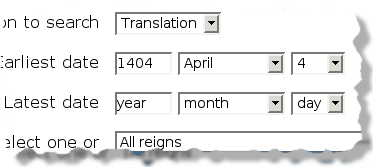
It is possible to specify a date or dates when running an advanced search. Entering a start date will exclude all documents prior to that date, and entering an end date will exclude all documents coming after that date. The earliest date in the records is 25 March 1235, and the latest is 25 March 1707.
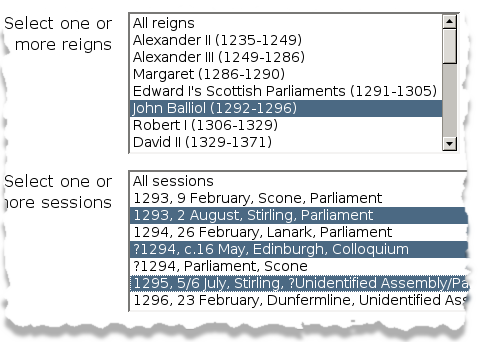
There is a list of reigns, and selecting one or more of these can help limit searches to these particular reigns. Selecting a reign will also display the parliamentary sessions in that reign. Selecting one or more sessions (multiple sessions can be highlighted by holding down the 'Ctrl' key while selecting) will further limit the search to these sessions.

Search hits are displayed in chronological order, a maximum of ten to each page. Additional results can be displayed by following the numbered navigation links at the bottom of the page.
Results are listed under the reign in which they occur. Next to the date of record the editorial heading or act title is displayed and underneath the highlighted search term and the surrounding text. Clicking on the linked text will take the user to the specific record in the database. Scroll down to see the search term highlighted within the record if this is not immediately apparent.
The default database view consists of three frames:
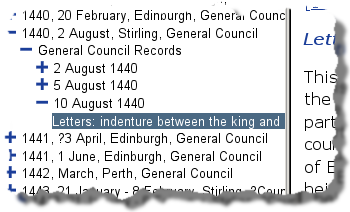
This gives clickable links to surrounding material and displays an at-a-glance view of how an individual record relates to the record as a whole. This view imitates the experience of browsing through the contents of a printed book. All the individual parliaments are ordered chronologically by reign. By clicking on the ‘plus’ and ‘minus’ icons, the subsidiary dates, editorial headings and act titles can be viewed or hidden.
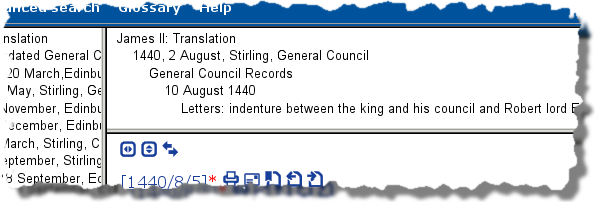
This provides the path to the current record, indicating the reign, parliamentary session and date under which the recod occurs.
When you need to see as much of the text on screen as possible, both these frames can be minimized by clicking on the respective icons. ‘hide/show index frame’ ( ) collapses or expands the browse menu. ‘hide/show header frame’ (
) collapses or expands the browse menu. ‘hide/show header frame’ ( ) collapses or expands the top menu.
) collapses or expands the top menu.
Each record within the database is assigned its own unique reference number for citation purposes, consisting of the year in which the parliament or session was first held and, in instances where there is more than one parliament or session per year, or where it aids the understanding of the reader, the month in which the parliament first sat, followed by a sequential entry number. For example, 1681/7/17 is the reference number for the seventeenth record of the July 1681 parliament. Next to the reference number is a pop-up giving source information such as the location of the manuscript, the relevant folio or page numbers and editorial commentary, if any, on the original document. Pop-ups can be viewed by moving the cursor over the red asterisk. Click the ‘close’ button to minimize the pop-up window.
To move between the manuscript record and the translated version, click on the jump link contained within the reference number text. See also the split-screen method described below.
RPS can be searched by reference number. For the search to
recognise a reference number, there must be at least one slash
(/). Wild cards (*) can be used to complete a reference number.
To find every record from, say, the 1633/6 session, enter
1633/6/*.
Left to right, the icons have the following functions:
-
It is possible to shrink (and expand) the browse menu and header navigation frames using these icons (
 and
and  ).
). -
To view the manuscript and translation record side by side, thus enabling a comparative view, click on the split screen icon (
 ). This places the manuscript transcription on the left and the translated version on the right. Note, that it is not possible to print or email this comparative view. Instead, manuscript and translation records must be printed or emailed separately, using the print and email functions in each respective versions.
). This places the manuscript transcription on the left and the translated version on the right. Note, that it is not possible to print or email this comparative view. Instead, manuscript and translation records must be printed or emailed separately, using the print and email functions in each respective versions. -
To generate a print-friendly view of each record, click on the ‘print this record’ icon (
 ). A new window will open in which the text of the record is displayed. Source and editorial pop-ups are converted to endnotes in this view. Use your browser’s standard print function to print.
). A new window will open in which the text of the record is displayed. Source and editorial pop-ups are converted to endnotes in this view. Use your browser’s standard print function to print.Sometimes more than one act will appear on a printable page. Rather than print out acts that you are not interested in, you can use the print preview option to find the page or pages you would like a hard copy of.
-
To send the text of a record to your email address, click on the ‘email this record’ icon (
 ). Complete the email address field and choose which format the text should be sent. Default is HTML view, which preserves formatting such as bold and italics. Plain text will result in simple unformatted text being delivered to your email address. In both HTML and plain text formats, source and editorial pop-ups are converted to endnotes.
). Complete the email address field and choose which format the text should be sent. Default is HTML view, which preserves formatting such as bold and italics. Plain text will result in simple unformatted text being delivered to your email address. In both HTML and plain text formats, source and editorial pop-ups are converted to endnotes.As with the print option, sometimes more that one act will be included in an email.
-
To generate a citation of each record for use in references and footnotes etc., click the ‘cite this record’ icon (
 ). The standard form for citing RPS and its individual records appears which can be cut and pasted into any word processor or text editor.
). The standard form for citing RPS and its individual records appears which can be cut and pasted into any word processor or text editor. -
To move between records, either forward or back, click on the respective arrow icon (
 and
and  ). As the cursor is moved over these icons, a roll-over box gives a summary of the content of the preceding and following record.
). As the cursor is moved over these icons, a roll-over box gives a summary of the content of the preceding and following record.
There are two kinds of pop-ups (the equivalent of footnotes in a conventional book) used within RPS. Asterisk pop-ups, found next to each record’s reference number, contain source information only, such as where the original manuscript can be found and its archival reference. Other comment on additional sources may also be included here.
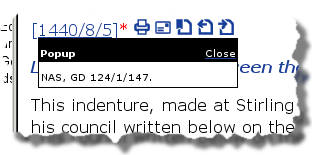
Dagger pop-ups are inserted at relevant points within the text and consist of other editorial commentary, such as notes about the manuscript itself, its condition and changes in handwriting, and, where necessary, detailed comparison between records with multiple sources. In the translated record, explanatory notes of historical terms are often included, as are comments on place names and on biographical information relating to individuals mentioned within the text.
